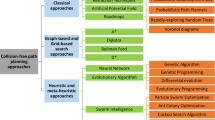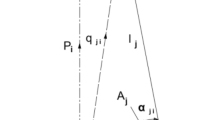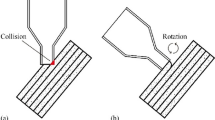Abstract
A segmented hyper-redundant manipulator can perform complicated operation tasks in a confined space due to its high flexibility and dexterity. However, the trajectory planning in a narrow space and obstacles environment is very challenging for the manipulator. In this paper, we propose a geometry method to simultaneously plan the end-effector pose and manipulator’s configuration. Firstly, the geometries of each segment are described by an inscribed arc (IA) and a circumscribed arc (CA). Then, the whole kinematics chain is considered as an inscribed curve (IC) or a circumscribed curve (CC) which are composed of multiple IAs or CAs. Furthermore, the IC and CC of the manipulator are divided into multiple spatial single-arc and double-arc groups according to requirements. The pose-configuration simultaneous planning is realized by the spatial single-arc/double-arc modeling and joints angles solving. By numerical iteration, the spatial arcs’ parameters are determined according to desired pose and boundary condition of obstacle avoidance. The angles of joints are analytically solved when the above parameters are known. Finally, a narrow space detection task is simulated and experimented respectively. The results verify the proposed method.
Similar content being viewed by others
References
Mo Y, Jiang Z H, Li H, et al. A kind of biomimetic control method to anthropomorphize a redundant manipulator for complex tasks. Sci China Tech Sci, 2020, 63: 14–24
Wang H, Wang H, Huang J, et al. Smooth point-to-point trajectory planning for industrial robots with kinematical constraints based on high-order polynomial curve. Mech Mach Theor, 2019, 139: 284–293
Yan L, Xu W, Hu Z, et al. Multi-objective configuration optimization for coordinated capture of dual-arm space robot. Acta Astronaut, 2020, 167: 189–200
Ding X L, Wang Y C, Wang Y B, et al. A review of structures, verification, and calibration technologies of space robotic systems for on-orbit servicing. Sci China Tech Sci, 2021, 64: 462–480
Xu W, Liu T, Li Y. Kinematics, dynamics, and control of a cable-driven hyper-redundant manipulator. IEEE/ASME Trans Mechatron, 2018, 23: 1693–1704
Sheng X J, Tang L, Huang X J, et al. Operational-space wrench and acceleration capability analysis for multi-link cable-driven robots. Sci China Tech Sci, 2020, 63: 2063–2072
Peng J, Xu W, Yang T, et al. Dynamic modeling and trajectory tracking control method of segmented linkage cable-driven hyper-redundant robot. Nonlinear Dyn, 2020, 101: 233–253
Chirikjian G S, Burdick J W. A hyper-redundant manipulator. IEEE Robot Automat Mag, 1994, 1: 22–29
Yuan H, Zhou L, Xu W. A comprehensive static model of cable-driven multi-section continuum robots considering friction effect. Mechanism Machine Theor, 2019, 135: 130–149
Dasgupta B, Gupta A, Singla E. A variational approach to path planning for hyper-redundant manipulators. Robot Auton Syst, 2009, 57: 194–201
Yahya S, Moghavvemi M, Mohamed H A F. Geometrical approach of planar hyper-redundant manipulators: Inverse kinematics, path planning and workspace. Simul Model Practice Theor, 2011, 19: 406–422
Dione A C A, Hasegawa S, Mitake H. Stable posture control for planar hyper-redundant arms using selective control points. Adv Robot, 2017, 31: 1338–1348
Tenreiro Machado J A, Lopes A M. A fractional perspective on the trajectory control of redundant and hyper-redundant robot manipulators. Appl Math Model, 2017, 46: 716–726
Ananthanarayanan H, Ordóñez R. Real-time inverse kinematics of (2n +1) dof hyper-redundant manipulator arm via a combined numerical and analytical approach. Mech Mach Theor, 2015, 91: 209–226
Chirikjian G S, Burdick J W. A modal approach to hyper-redundant manipulator kinematics. IEEE Trans Robot Automat, 1994, 10: 343–354
Xu W, Mu Z, Liu T, et al. A modified modal method for solving the mission-oriented inverse kinematics of hyper-redundant space manipulators for on-orbit servicing. Acta Astronaut, 2017, 139: 54–66
Zhou J, Wu X J, Liu Z R. Distributed coordinated adaptive tracking in networked redundant robotic systems with a dynamic leader. Sci China Tech Sci, 2014, 57: 905–913
Jiokou Kouabon A G, Melingui A, Mvogo Ahanda J J B, et al. A learning framework to inverse kinematics of high dof redundant manipulators. Mech Mach Theor, 2020, 153: 103978
Mu Z, Yuan H, Xu W, et al. A segmented geometry method for kinematics and configuration planning of spatial hyper-redundant manipulators. IEEE Trans Syst Man Cybern Syst, 2020, 50: 1746–1756
Chirikjian G S, Burdick J W. A geometric approach to hyper-redundant manipulator obstacle avoidance. J Mech Des, 1992, 114: 580–585
Maciejewski A A, Klein C A. Obstacle avoidance for kinematically redundant manipulators in dynamically varying environments. Int J Robot Res, 1985, 4: 109–117
Ashwin K P, Chaudhury A N, Ghosal A. Efficient representation of ducts and cluttered spaces for realistic motion planning of hyperredundant robots through confined paths. Comput-Aided Des, 2020, 119: 102777
Xidias E K. Time-optimal trajectory planning for hyper-redundant manipulators in 3D workspaces. Robot Comput-Integr Manuf, 2018, 50: 286–298
Chembuly V V M J S, Voruganti H K. An efficient approach for inverse kinematics and redundancy resolution of spatial redundant robots for cluttered environment. SN Appl Sci, 2020, 2: 1012
Tang L, Zhu L M, Zhu X Y, et al. Confined spaces path following for cable-driven snake robots with prediction lookup and interpolation algorithms. Sci China Tech Sci, 2020, 63: 255–264
Peng J, Xu W, Liu T, et al. End-effector pose and arm-shape synchronous planning methods of a hyper-redundant manipulator for spacecraft repairing. Mech Mach Theor, 2020, 155: 104062
Safeea M, Béarée R, Neto P. Collision avoidance of redundant robotic manipulators using Newton’s method. J Intell Robot Syst, 2020, 99: 673–681
Dalla V K, Pathak P M. Curve-constrained collision-free trajectory control of hyper-redundant planar space robot. P I Mech Eng I-J Syst Control Eng, 2017, 231: 282–298
Yang C, Geng S, Walker I, et al. Geometric constraint-based modeling and analysis of a novel continuum robot with shape memory alloy initiated variable stiffness. Int J Robot Res, 2020, 39: 1620–1634
Liu T L, Mu Z G, Xu W F, et al. Improved mechanical design and simplified motion planning of hybrid active and passive cable-driven segmented manipulator with coupled motion. In: 2019 IEEE/RSJ International Conference on Intelligent Robots and Systems (IROS). Macao, 2019. 5978–5983
Hu Z H, Yang T W, Xu W F et al. A kinematic equivalence trajectory planning method of hybrid active and passive cable-driven segmented hyper-redundant manipulator. In: 2019 IEEE International Conference on Robotics and Biomimetics (ROBIO). Dali, 2019. 1280–1285
Xu W, Liang B, Li B, et al. A universal on-orbit servicing system used in the geostationary orbit. Adv Space Res, 2011, 48: 95–119
Li M, Kang R, Branson D T, et al. Model-free control for continuum robots based on an adaptive kalman filter. IEEE/ASME Trans Mechatron, 2018, 23: 286–297
Xu K, Simaan N. Analytic formulation for kinematics, statics, and shape restoration of multibackbone continuum robots via elliptic integrals. J Mech Robot, 2009, 2: 011006
Author information
Authors and Affiliations
Corresponding authors
Additional information
This work was supported by the Key Research and Development Program of Guangdong Province (Grant No. 2019B090915001), the National Key R&D Program of China (Grant No. 2018YFB1304600), the National Natural Science Foundation of China (Grant No. 61803125), and the Basic Research Program of Shenzhen (Grant Nos. JCY20180507183610564, JCYJ20190806144416980, and JSGG20200103103401723).
Rights and permissions
About this article
Cite this article
Hu, Z., Yuan, H., Xu, W. et al. A geometric method based on space arc for pose-configuration simultaneous planning of segmented hyper-redundant manipulators. Sci. China Technol. Sci. 64, 2389–2407 (2021). https://doi.org/10.1007/s11431-020-1811-8
Received:
Accepted:
Published:
Issue Date:
DOI: https://doi.org/10.1007/s11431-020-1811-8




